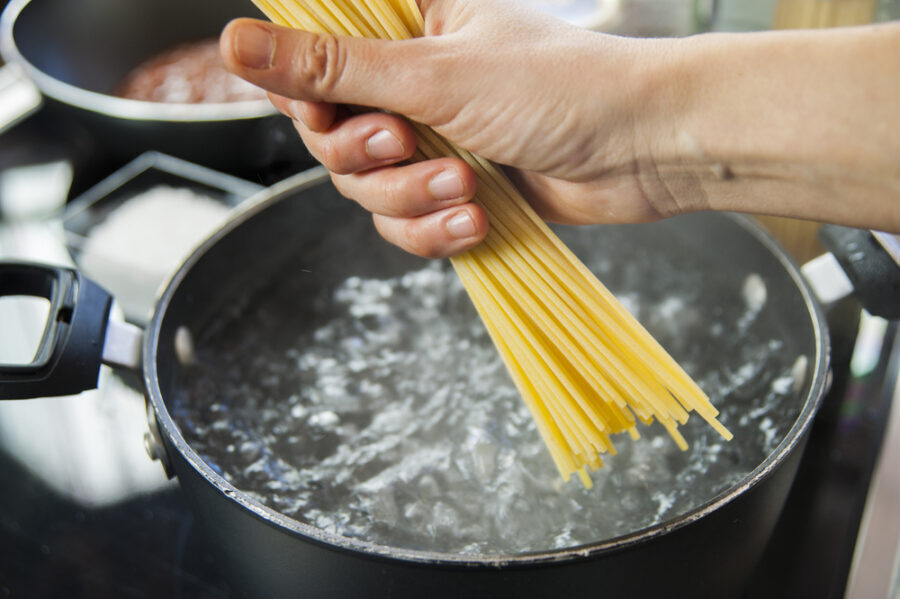Cooking pasta is not that difficult! Yet it often doesn’t go quite the way you want it to. We often get asked how best to cook a pasta such as spaghetti or fusilli. With these handy tips, it will always go well from now on. Cooking pasta the way they do in Italy…
Cooking pasta
Pasta cooking is at the heart of any good pasta dish. Often all the attention is focused on the pasta sauce and cooking pasta is often seen as difficult and boring. A pity, because with a few small adjustments, you can cook the pasta effortlessly and much better. Which of course can only benefit your pasta dish! So it’s important when you want to cook spaghetti or tagliatelle for example. After answering a few simple questions, you will go for the best result every time. A few questions to keep in mind when cooking pasta:
- What is the best pan to cook pasta in?
- How much water do you put in the pan?
- What type of pasta is best to use?
- Should I add salt during the cooking of the pasta?
- How long should you cook the pasta before it is done?
- How do you prevent the pasta from sticking?
- How much pasta should you cook per person?
- Cooking pasta with or without a lid?
Cooking pasta with a large pot
Cooking pasta starts with choosing the right pan. There are many different kinds of pans. Make sure you choose the biggest! Pasta needs space to grow in the pan. Therefore, always use a large pan that holds a lot of water.
Cooking pasta in Italy is almost always done with a pasta pan. This is simply because it is easier and gives the best results. Don’t have a pasta pan at home? For a few euros you can buy a good pasta pan. Cooking pasta can of course also be done with a normal pan. As long as a lot of water fits in it!
Cooking pasta with the right amount of water
As mentioned earlier, pasta needs a lot of water. Simply put, use at least 1 liter for every 100 grams of pasta. Pasta absorbs water as it cooks. During pasta cooking, pasta can soak up twice its own weight in water. This is actually the main reason for using a lot of water.
In addition, you need to keep the pasta moving well. Pasta has a tendency to stick together. You can easily prevent this by stirring the pasta well every now and then. “In Italy it is often said that the pasta has to dance in the pan. By keeping the pasta moving during cooking, you prevent sticky pasta.
The right type of pasta
To easily cook pasta and get the best results, you need a certain type of pasta. In Italy, pasta made from hard wheat types is actually only used. Therefore, the most commonly used type of pasta is pasta made from durum wheat.
The advantage of durum wheat pasta is that it does not fall apart during cooking. During the cooking of durum wheat pasta, the water remains almost clear. Once you use the “cheaper” types of pasta you will see that the water becomes cloudy and milky.
In addition, pasta made from durum wheat types ensure that the pasta cooks easily and that the inside of the pasta is cooked just as much as the outside. Choose quality, so choose a pasta made from durum wheat.
Adding or not adding salt during pasta cooking?
You can cook pasta with or without salt. This all has to do with what you like. Usually a little salt is added to the water during the cooking of the pasta. If you want to add salt during pasta cooking, add it as soon as the water boils. Use about 10 grams of salt per 3 liters of water.
Adding salt to the pasta water will give the pasta just that little bit more flavor. This will make your pasta dish even tastier! You can read more about cooking pasta and using salt on our blog: ‘To use or not to use salt while cooking pasta?
How long should you cook pasta?
Cooking pasta begins, of course, by adding the pasta to the water in the pan. Do not add the pasta until the water in the pan is boiling. You will notice that as soon as you add the pasta, the water will stop boiling for a moment. Keep the gas on high so that the water starts boiling again.
Once you have added the pasta to the pan, the real work begins. Keep the pasta moving well so the pasta doesn’t stick together. This is especially important when cooking a pasta like spaghetti or tagliatelle.
In between, check the packaging to see how long you need to cook the pasta before it is done. Take the number of minutes as a guideline and not as an absolute truth. It all comes down to what you like. In the middle and south of Italy, pasta is often eaten “al dente”. In simple terms, this means that the inside of the pasta is still a little hard after cooking.
In the north of Italy, pasta is often eaten a little softer. Again, it all comes down to taste. How do you know when the pasta is cooked the way you like it? Simple: taste it! As soon as the number of minutes indicated on the packaging has elapsed, take a pasta string from the pan and taste it.
Taste whether enough salt has been added to the water and taste whether the pasta has the “bite” you like. Is this the case? Then drain the pasta.
The cooking time for different types of pasta
There are many types of pasta and almost all of them have a different cooking time. For this reason, we have listed below how long each type of pasta must be cooked. All times are indicative, of course. Always look carefully at the packaging so you know for sure how long the pasta must be cooked:
Spaghetti: 9 min.
Penne: 10 min.
Linguine: 9 min.
Fusilli: 9 min.
Fettuccine: 5 min.
Tagliatelle: 5 min.
Farfalle: 11 min.
Conchiglie: 12 min.
Pappardelle: 6 min.
Macaroni: 8 min.
Fresh pasta: 4 min.
Cooking spaghetti
We often get asked if cooking spaghetti is different than cooking a short type of pasta like penne. We can keep the answer simple: no, spaghetti is cooked the same way as any other type of pasta. The only thing to take into account is the cooking time of spaghetti. On average it takes about 9 minutes. Always look carefully at the packaging so you know for sure how long the spaghetti needs to cook.
Cooking pasta without it sticking
A common question is how to make sure pasta doesn’t stick once you’ve cooked it. The answer is simple: throw the pasta right in with the pasta sauce! It can be that simple. In Italy, pasta is put right into the pan of sauce. This gives the pasta no time to start sticking together.
You often hear tips about adding olive oil to the cooking water. This often does not work well. First, because oil floats on water. The pasta barely comes into contact with the oil during cooking.
Second, once the oil touches the pasta, it forms a smooth layer around the pasta. This indeed prevents the pasta from sticking together but this also ensures that the pasta sauce does not stick to the pasta. And what is more annoying than pasta that does not want to mix with the pasta sauce. So keep it simple and add the pasta to the pasta sauce right after you drain it!
How much pasta to cook per person?
How much pasta you need to cook per person depends on the pasta dish you are making and how much pasta sauce it contains. As a rule, you can use 100 grams of pasta per adult.
For the bigger eaters among us, 125 grams is a better amount. Do you have pasta with eggs in the dough? Then keep in mind that this is a more nutritious pasta. In this case, just keep 100 grams per person.
To use a lid or not to use a lid during the cooking of pasta?
It is best not to put a lid on the pan while pasta is cooking. The lid often causes the water to foam and spills over the edge of the pan. You have also just read that you should keep the pasta moving, without the lid this is of course much easier!
Cooking fresh pasta
Fresh pasta should be cooked just like dried pasta. However, keep in mind that fresh pasta can be cooked a little shorter before it is done. This is because fresh pasta contains a lot of water. This means that fresh pasta does not need to be cooked as long.

